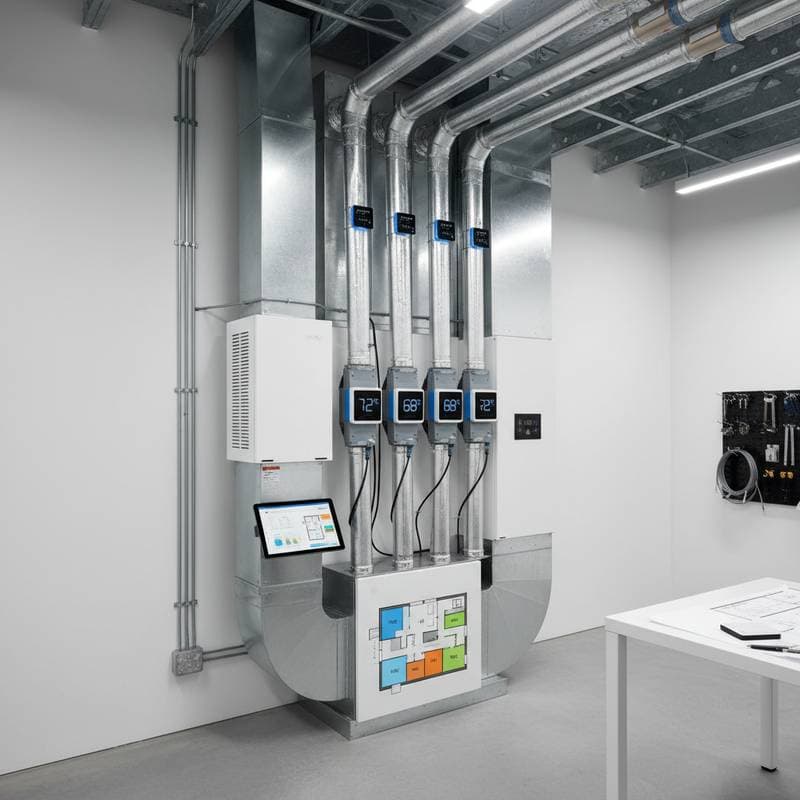Strategies for Controlling Indoor Humidity to Prevent Mold in the 2025 Wet Winter
The Connection Between Indoor Humidity and Mold Development
In a wet winter, indoor moisture levels increase when cold exterior air encounters warmer interior conditions. This interaction elevates humidity, fostering mold in areas such as basements, bathrooms, attics, and concealed wall spaces. Mold flourishes in moist environments, making humidity management vital for safeguarding both property and occupant health. The recommended indoor humidity range stands at 30 to 50 percent, a threshold that discourages mold spore adhesion and dissemination.
This resource outlines effective humidity regulation techniques, highlights the contributions of HVAC systems and dehumidifiers, and provides actionable protocols to inhibit mold establishment during winter months. Residents in humid coastal zones or rain-prone locales benefit most from these insights, ensuring a secure and pleasant home atmosphere.
Primary Influences on Indoor Humidity
Multiple variables determine moisture accumulation within residences. Recognizing these enables selection of targeted humidity mitigation methods.
Outdoor Environmental Conditions
Areas experiencing regular precipitation or maritime influences exhibit elevated baseline humidity. When external moisture infiltrates via structural breaches or ventilation deficiencies, it amplifies interior dampness, particularly in subterranean and subfloor regions. Monitoring local weather patterns aids in anticipating and countering seasonal surges.
Ventilation Practices in the Home
Inadequate air circulation retains vaporstasks like meal preparation, bathing, and clothes washing. Exhaust fans in bathrooms and kitchens, combined with attic and basement airflow solutions, prove indispensable for moisture dispersal. Install timers on fans to operate them for 20 to 30 minutes post-activity, enhancing efficiency without excessive energy use.
Insulation Quality and Building Envelope Integrity
Inadequate thermal barriers promote condensation on surfaces like walls, windows, and ceilings due to temperature gradients. Apply weatherstripping to doors and windows, and add insulation to attics and walls to minimize these differentials. Professional audits can identify weak points, such as uninsulated pipes, for targeted reinforcements.
Performance of Heating and Cooling Equipment
HVAC units significantly impact humidity balance by extracting moisture during operation. Units that activate and deactivate too often fail to dehumidify adequately, allowing excess vapor to linger. Schedule biannual servicing to clean coils and filters, and consider variable-speed models that maintain steady conditions.
Daily Household Routines
Common practices contribute substantially to indoor moisture. Extended bathing sessions release steam, while indoor clothes drying and uncovered pot boiling introduce vapors. Opt for low-flow showerheads to reduce water usage by up to 50 percent, and always employ exhaust systems during these activities to redirect humidity outdoors.
Vulnerable Home Zones for Mold in Damp Conditions
Certain locations within a structure accumulate moisture more readily due to design or usage patterns. Proactive surveillance in these spots facilitates prompt intervention during humidity spikes.
| Area | Risk Level | Prevention Measures |
|---|---|---|
| Basement | High | Deploy a dedicated dehumidifier; seal cracks in foundations with hydraulic cement. |
| Bathroom | High | Activate exhaust fans during and after use; dry surfaces with microfiber cloths. |
| Kitchen | Medium | Employ range hoods for cooking; promptly dry countertops and fixtures. |
| Attic | Medium | Install ridge and soffit vents; apply radiant barrier insulation. |
| Laundry Room | Medium | Direct dryer vents outside; use vented drying racks sparingly. |
| Windowsills | Low to Medium | Regularly clear condensation; upgrade to double-pane, low-E coated glass. |
Frequently Asked Questions on Humidity Management
Indicators of Excessive Home Humidity
Condensation on glass surfaces or a persistent musty scent signals humidity exceeding ideal levels. Invest in a digital hygrometer, placed in multiple rooms, for precise monitoring; aim to log readings daily during wet periods. Ongoing damp textures or observable mold patches necessitate immediate moisture source identification and remediation.
Optimal Winter Humidity for Indoor Spaces
Sustain levels from 30 to 50 percent to deter mold and frost formation. In frigid regions, target the lower end to prevent window icing, adjusting via HVAC settings in increments of 5 percent for comfort evaluation. Pair this with indoor plants like peace lilies, which naturally absorb minor moisture excesses.
Continuous Dehumidifier Use in Winter
Dehumidifiers suit year-round operation, contingent on ambient temperatures. Standard models perform optimally above 60 degrees Fahrenheit; for chillier basements, select cold-weather variants or integrate whole-home systems tied to HVAC for uniform coverage. Empty reservoirs weekly and replace filters quarterly to uphold performance.
Role of HVAC in Humidity Regulation
HVAC systems inherently dehumidify air through cooling cycles, with heating modes supporting balance in winter. Upgrade to units with built-in humidistats or connect to smart thermostats for automated adjustments based on real-time data. Annual professional tune-ups ensure coils remain efficient at moisture removal.
Symptoms of Humidity-Induced Mold
Look for black or green discoloration on surfaces, blistering paint, musty odors, and heightened respiratory irritation. These cues demand swift action: isolate the area, enhance ventilation, and consult specialists for remediation to halt progression and restore air purity.
Securing Professional Assessments for Humidity and Mold Solutions
Expert inspections pinpoint tailored remedies by evaluating ventilation, insulation, and moisture profiles. Certified HVAC professionals deliver recommendations on equipment and modifications suited to specific home configurations.
Essential Inquiries for Service Providers
- What humidity target aligns with my residence's dimensions and regional climate?
- Is a centralized dehumidifier preferable to several standalone devices?
- How does the proposed solution mesh with current HVAC infrastructure?
- What routine upkeep ensures sustained operation?
- Do energy-saving options qualify for incentives or rebates?
- How frequently must inspections and cleanings occur?
- Can you conduct tests in enclosed spaces like attics and subfloors?
- What guarantees apply to components and workmanship?
- What timeline applies to setup or enhancements?
- Which practices promote ongoing air quality?
Sustaining Humidity Balance for Long-Term Home Protection
Effective humidity oversight extends beyond immediate relief to preserve structural integrity and foster salubrious air. Regular evaluations of systems, coupled with vigilant maintenance of vents and filters, fortify defenses against seasonal threats. Embrace these protocols alongside expert input to ensure enduring dryness, cleanliness, and mold resistance amid challenging winter weather.





